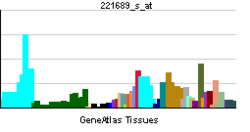PIGP
| Phosphatidylinositol glycan anchor biosynthesis, class P | |||||||||||||
|---|---|---|---|---|---|---|---|---|---|---|---|---|---|
| Identifiers | |||||||||||||
| Symbols | PIGP ; DCRC; DCRC-S; DSCR5; DSRC | ||||||||||||
| External IDs | OMIM: 605938 MGI: 1860433 HomoloGene: 32444 GeneCards: PIGP Gene | ||||||||||||
| EC number | 2.4.1.198 | ||||||||||||
| |||||||||||||
| RNA expression pattern | |||||||||||||
 | |||||||||||||
| More reference expression data | |||||||||||||
| Orthologs | |||||||||||||
| Species | Human | Mouse | |||||||||||
| Entrez | 51227 | 56176 | |||||||||||
| Ensembl | ENSG00000185808 | ENSMUSG00000022940 | |||||||||||
| UniProt | P57054 | Q9JHG1 | |||||||||||
| RefSeq (mRNA) | NM_153681 | NM_001159616 | |||||||||||
| RefSeq (protein) | NP_710148 | NP_001153088 | |||||||||||
| Location (UCSC) |
Chr 21: 37.06 – 37.07 Mb |
Chr 16: 94.36 – 94.37 Mb | |||||||||||
| PubMed search | |||||||||||||
Subunit P of phosphatidylinositol N-acetylglucosaminyltransferase is an enzyme that in humans is encoded by the PIGP gene.[1][2][3]
This gene encodes an enzyme involved in the first step of glycosylphosphatidylinositol (GPI)-anchor biosynthesis. The GPI anchor is a glycolipid found on many blood cells that serves to anchor proteins to the cell surface. The encoded protein is a component of the GPI-N-acetylglucosaminyltransferase complex that catalyzes the transfer of N-acetylglucosamine (GlcNAc) from UDP-GlcNAc to phosphatidylinositol (PI). This gene is located in the Down Syndrome critical region on chromosome 21 and is a candidate for the pathogenesis of Down syndrome. Alternatively spliced transcript variants encoding different isoforms have been described.[3]
References
- ↑ Shibuya K, Kudoh J, Minoshima S, Kawasaki K, Asakawa S, Shimizu N (Jun 2000). "Isolation of two novel genes, DSCR5 and DSCR6, from Down syndrome critical region on human chromosome 21q22.2". Biochem Biophys Res Commun 271 (3): 693–8. doi:10.1006/bbrc.2000.2685. PMID 10814524.
- ↑ Ferrando-Miguel R, Cheon MS, Lubec G (Jun 2004). "Protein levels of genes encoded on chromosome 21 in fetal Down Syndrome brain (Part V): overexpression of phosphatidyl-inositol-glycan class P protein (DSCR5)". Amino Acids 26 (3): 255–61. doi:10.1007/s00726-004-0065-9. PMID 15221505.
- 1 2 "Entrez Gene: PIGP phosphatidylinositol glycan anchor biosynthesis, class P".
Further reading
- Gerhard DS, Wagner L, Feingold EA, et al. (2004). "The Status, Quality, and Expansion of the NIH Full-Length cDNA Project: The Mammalian Gene Collection (MGC)". Genome Res. 14 (10B): 2121–7. doi:10.1101/gr.2596504. PMC 528928. PMID 15489334.
- Strausberg RL, Feingold EA, Grouse LH, et al. (2003). "Generation and initial analysis of more than 15,000 full-length human and mouse cDNA sequences". Proc. Natl. Acad. Sci. U.S.A. 99 (26): 16899–903. doi:10.1073/pnas.242603899. PMC 139241. PMID 12477932.
- Choi DK, Suzuki Y, Yoshimura S, et al. (2001). "Molecular cloning and characterization of a gene expressed in mouse developing tongue, mDscr5 gene, a homolog of human DSCR5 (Down syndrome Critical Region gene 5)". Mamm. Genome 12 (5): 347–51. doi:10.1007/s003350010283. PMID 11331941.
- Watanabe R, Murakami Y, Marmor MD, et al. (2000). "Initial enzyme for glycosylphosphatidylinositol biosynthesis requires PIG-P and is regulated by DPM2". EMBO J. 19 (16): 4402–11. doi:10.1093/emboj/19.16.4402. PMC 302040. PMID 10944123.
- Togashi T, Choi DK, Taylor TD, et al. (2001). "A novel gene, DSCR5, from the distal Down syndrome critical region on chromosome 21q22.2". DNA Res. 7 (3): 207–12. doi:10.1093/dnares/7.3.207. PMID 10907851.
- Hattori M, Fujiyama A, Taylor TD, et al. (2000). "The DNA sequence of human chromosome 21". Nature 405 (6784): 311–9. doi:10.1038/35012518. PMID 10830953.